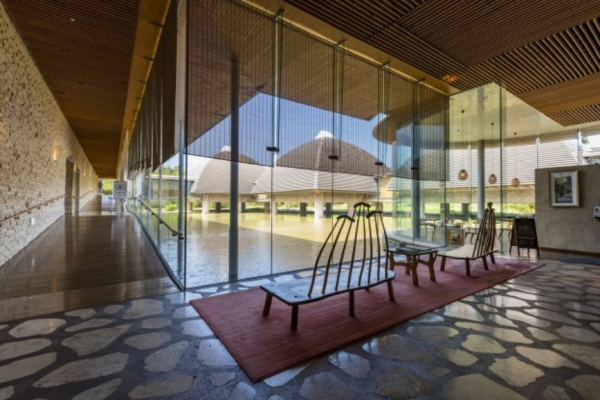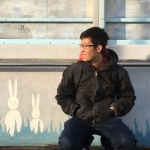Amami Oshima: Your UNESCO World Natural Heritage application is pending

Amami Oshima (奄美大島) is one of Kagoshima’s (鹿児島) islands, and part of the Amami Islands (奄美群島 Amami-guntō) (Amami Oshima, Tokunoshima, Okinoerabujima, and Kikaijima). At about 712 km2, it’s pretty close in size to Singapore.
Amami Oshima is a biodiversity hotspot, and contains many globally threatened species, which fuelled its bid for UNESCO World Natural Heritage status (in conjunction with Tokunoshima islands and some parts of Okinawa). There’s no good list of these species in English, but the Amami City guidebook lists them out in Japanese (scroll down to pages 8-15, pictures included). Amami is also famous for its beaches and summer activities, whale watching in the winter, and great food that has many similarities to its neighbour Okinawa (沖縄).
It also has chicken rice.
Amami Chicken Rice—same same, but different.

Side dishes of Amami Keihan. Also featured: chicken sashimi, a miracle realised by Japan’s incredible food safety standards. (Image credit: Jia Han)
Amami Keihan (奄美鶏飯 Amami chicken rice) is a strange relative to Singapore’s beloved Hainan version. Here’s a table for comparison:
|
Amami Keihan |
Hainan Chicken Rice |
|
|
Rice: |
Fluffy, chewy Japanese rice |
Fragrant jasmine rice grains, firm, cooked in chicken fat and stock |
|
Chicken: |
Shredded chicken breast meat |
Thigh or breast meat |
|
Frills: |
Thin omelette slices, pickled ginger, shiitake mushrooms, spring onions, dried seaweed |
Sauces, sliced cucumber, cilantro |
The real star of Amami Keihan is a delicate and tasty chicken soup. You ladle it over your rice, and suddenly you can polish off thrice as much food as you normally do.
(Video credit: Jia Han)
All in all, Amami Keihan is the much healthier and less sinful alternative, a hearty go-to comfort food that you would crave while bedridden with fever, while Hainan Chicken Rice is the artery-clogger that makes life worth living. There’s a time and place for both, if you ask me.
Hisakura (けいはん ひさ倉)
Address: 516 Yanyu, Tatsugo, Oshima-gun, Kagoshima 894-0101
Access: 1-minute walk from Yanyu Hisakura-mae Bus Stop (屋入ひさ倉前)
Opening hours: 11am–8pm
Cost (Amami Keihan): ¥1,100
Tel: +81 99-762-2988
Brown Sugar and Shochu

Brown Sugar Shochu from Tomita Brewery. (Image credit: Tomita Brewery)
Besides savoury chicken, Amami also has sweet brown sugar. The Amami Islands are the only place allowed to produce shochu (焼酎) from brown sugar. Long story short, the islanders switched their liquor base ingredient from rice to brown sugar during WWII, due to a shortage of rice. However, the Liquor Tax Act of Japan imposed a high tax on sugar-based beverages (e.g. rum), which were classified as “spirits”. To save the post-war Amami Islands’ economy, the Japanese government made an exception that the Amami Islands would be allowed to produce alcohol from brown sugar, classified as “shochu”, which had a much lower tax rate. Incidentally, brown sugar shochu is still a distilled product like whiskey, and therefore has no sugar content, despite its name.

Tomita Brewery. The facility is as small as the owner’s heart is big. (Image credit: Jia Han)
Interestingly, while Amami is famous for brown sugar products and shochu, most of the brown sugar actually comes from Okinawa, and the history of brown sugar on Amami is not well known or promoted. I learned the reason for this from Mr. Tomita, when I visited the Tomita Brewery.
The reason for this is that when the Japanese government made the exception on brown sugar shochu production, Okinawa had not yet been returned to Japan. Despite Okinawa and Amami Islands’ shared history of making brown sugar shochu, only the Amami Islands were allowed to make it. The Japanese government decided to heavily subsidise Okinawan sugarcane instead, the raw ingredient for brown sugar. Even today, only a small volume of sugarcane and brown sugar is produced locally on Amami, as it is more expensive compared to importing the Okinawan alternatives.
(Video credit: Jia Han)
I was allowed to watch at one small brown sugar production facility, Amami Kyoraumi Koubow (奄美きょら海工房), where they reduce the sugarcane juice down to brown sugar in a laborious process. The gruff worker snuck me a bite, and fresh brown sugar truly hits different.
The facility also makes sea salt in the same tanks, as the production process is quite similar. There is also a bakery and cafe attached with a lovely view of the sea and a unique mozuku seaweed carbonara pasta.
Tomita Brewery (富田酒造場)
Address: 7-8 Nazeirifunecho, Amami, Kagoshima 894-0034
Access: 6-minute drive from Naze Port (名瀬港)
Opening hours (Tours): 10am–4pm (Case-by-case on mornings, weekends, and public holidays)
Admission fee (Tour): ¥500, sampling included.
Tel: +81 99-752-0043
Amami Kyoraumi Koubow (奄美きょら海工房)
Address: 1254-1 Kasaricho Oaza Yoan, Amami, Kagoshima 894-0508
Access: 10-minute drive from Amami Airport (奄美空港)
Opening hours: 11am–6.30pm
Tel (Shop): +81 99-752-7345
Tel (Restaurant): +81 99-763-2208
Tsumugi

(Image credit: Kagoshima Prefecture Visitors Bureau)
To prove I did not spend my whole trip stuffing my face, here’s a cultural share: tsumugi (紬).
Tsumugi is silk pongee, and Amami Oshima tsumugi goes through a traditional mud-dyeing process in the iron-rich mud of Amami. Here’s one of the workers in action.
(Video credit: Jia Han)

The traditional colour range of tsumugi colours. (Image credit: Jia Han)
The pure white silk on the left is pre-dyeing. The silk is then dyed with Japanese hawthorn シャリンバイ sharinbai), and the brown deepens after 4, 8, 16, 20 repetitions. The silk is then put through mud-dyeing as well, and the glossy black colour is the last of the range of colours available. With the introduction of modern artificial colouring, the range of colours has increased greatly, while the amount of labour required has fallen. However, some craftspeople are still keeping the traditional art alive, and the earthy colours of traditional Amami tsumugi still hold a special prestige.
The time-consuming dyeing is just one step in a long process of creating tsumugi, and each kimono can take up to 10 months to complete.

(Image credit: Jia Han)
The final step: weaving. The individually dyed threads are finally put together, and any mistakes are manually remedied. The craftswoman told me that she can only weave 30cm in an 8-hour day.
Oshima Tsumugimura (大島紬村 Oshima Tsumugi Village)
Address: 1945 Akaogi, Tatsugo, Oshima-gun, Kagoshima 894-0411
Access: 2-minute walk from Oshima Tsumugimura Iriguchi Bus Stop (大島紬村入口)
Opening hours: 9am–5pm (except New Year’s Eve and New Year’s Day)
Admission fee: ¥500 (Shopping-only is free)
Tel: +81 99-762-3100
Access to Amami Oshima
I was surprised to find this out myself, but Amami Oshima actually has direct flights to Tokyo, Osaka, and Fukuoka! Of course, there are also flights to neighbouring Okinawa and the rest of Kagoshima. That’s incredible transport access.
No trains run on Amami Oshima (thanks for hosting my article anyway, JR Times), and the best way to get around the island is by rental car. You can also buy a 1/2/3-day bus pass (¥2,100, ¥3,150, and ¥4,200 respectively), or rent a bicycle. Island weather can be fickle, with coastal showers blowing in and abating at strange times, so take note if you’re going with the cycling option.
Also, here are some good links to plan a trip with:
- Amami Tourism Bureau Website
Full of good general information and maps, although riddled with Japanese even on the English page. - Transportation Options
By Amami Tourism Bureau. Phone numbers are missing on the English page, so here’s the Japanese page put through Google Translate.
The Japanese government had put forth the bid for UNESCO World Natural Heritage status back in early 2016, and revamped the bid in 2019. However, on-site surveys by UNESCO were put off in 2019 due to the pandemic. On 10 May 2021, UNESCO advisory body International Union for Conservation of Nature (IUCN) recommended the bid to UNESCO. Such recommendations are usually accepted. If it succeeds, this will be the fifth World Natural Heritage Site that Japan has, and Kagoshima will be the only prefecture to have two (or one and a half, since we’re sharing this one with Okinawa).
Header image credit: Kagoshima Prefecture Visitors Bureau





